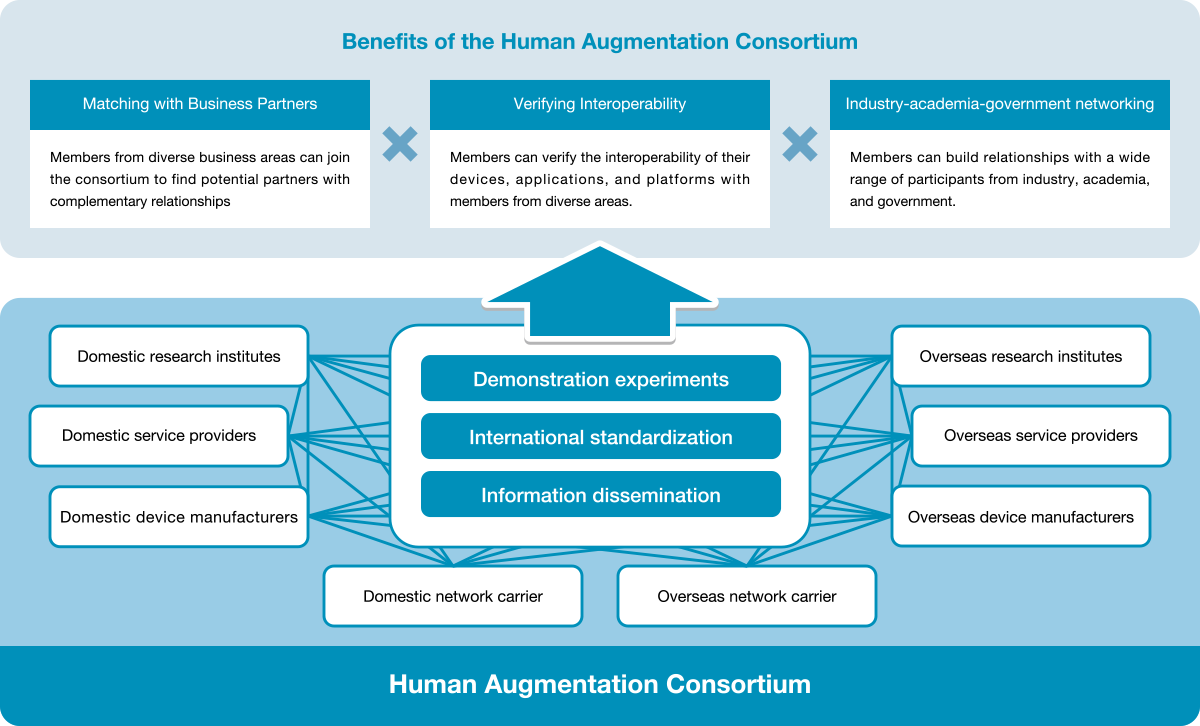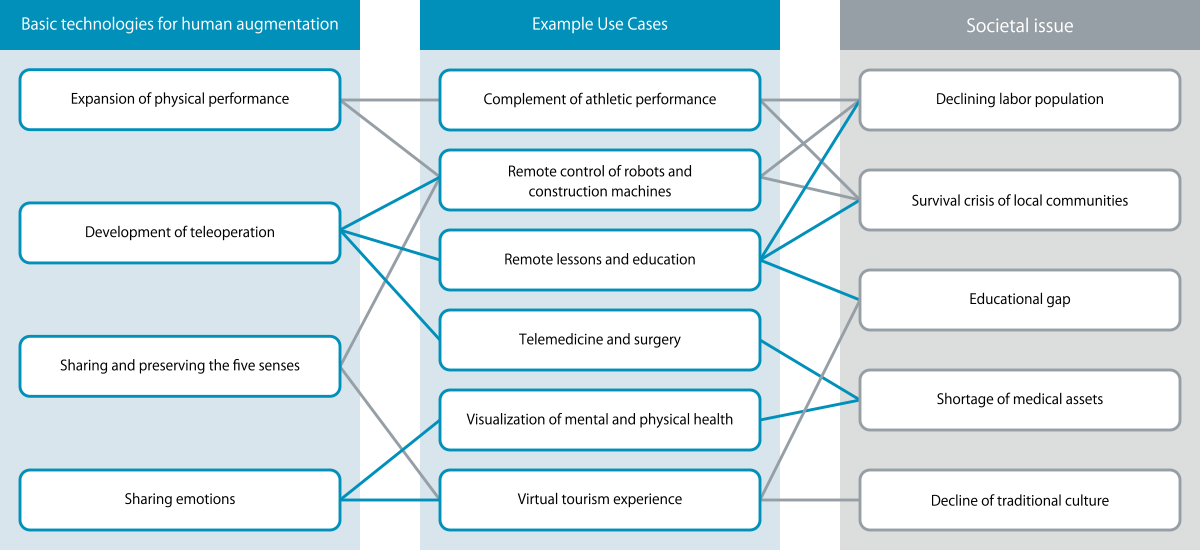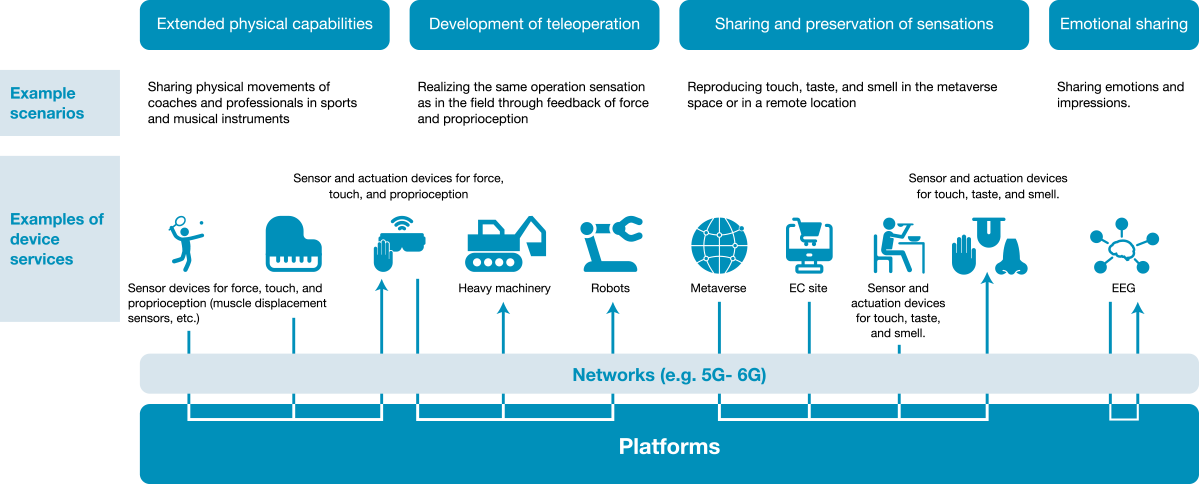About consortium
Overview of the Consortium

The Consortium was established as part of the Cabinet Office-led national project, The Cross-ministerial Strategic Innovation Promotion Program (SIP) Phase 3, “Development of Foundational Technologies and Rules for Expansion of the Virtual Economy”*, with the aim of forming and expanding the human augmentation ecosystem and solving societal issues through these human augmentation technologies in cross-industry, industry-government-academic collaboration among companies in various industrial fields. Participating companies and academic experts will work together to verify the elements of systems that realize human augmentation (devices, platforms, and applications), promoting international standardization of technologies necessary for human augmentation, and disseminating information related to human augmentation through symposiums and white papers.
Organizational Structure
Executive Committee
| Leader | Masaaki Mochimaru (Cabinet Office, Program Director for the Cross-ministerial Strategic Innovation Promotion Program (SIP) Phase 3, “Development of Foundational Technologies and Rules for Expansion of the Virtual Economy”) |
|---|---|
| Sub-Leader | Emi Tamaki (Professor at Graduate School of Engineering, The University of Tokyo; Professor at Faculty of Engineering, University of Ryukyus) |
| Sub-Leader | Takehiro Nakamura (CSO and Corporate Evangelist at NTT DOCOMO, Inc.) |
Secretariat
Mitsubishi Research Institute, Inc.
What is human augmentation?

Human augmentation is attracting attention in various industries such as tourism, education, manufacturing, construction, and healthcare as a means to solve societal issues like educational disparities, declining labor population, and the decline of traditional culture. For example, augmenting physical movements could improve the effectiveness of instruction in sports and musical instruments. By sharing physical movements between instructors and students through wearable devices connected to a network, students can directly experience and learn from the instructor’s muscle and joint movements with their own bodies. If this allows students in areas where instructors are not nearby to receive highly effective instruction, it will help to eliminate the educational disparities.
An image of human augmentation as envisioned by the Human Augmentation Consortium

Through the platform, various devices for sensing and actuation, as well as services such as metaverse and e-commerce sites, can be connected to extend physical capabilities, develop teleoperation, share and store feeling, and share emotions
*The Cross-ministerial Strategic Innovation Promotion Program(SIP) is a national program led by the Cabinet Office, established based on the Comprehensive Strategy for Science, Technology and Innovation and the Japan Revitalization Strategy. In the SIP Phase 3, the Council for Science, Technology and Innovation (CSTI) of the Cabinet Office sets issues that are important for solving societal issues and for the Japanese economy and industrial competitiveness through backcasting towards the realization of Society 5.0, and determines the program director (PD) and budget allocation in a top-down manner. Through industry-academia-government collaboration, this project aims to promote R&D in an integrated manner from basic research to social implementation of cross-sectoral initiatives that require collaboration between ministries and agencies. “The Development of Foundational Technologies and Rules for Expansion of the Virtual Economy” aims to create and expand the “Virtual Economy Zone,” a new economic zone that not only generates value in the cyberspace but also returns that value to the physical space, through interaction in both the cyber and physical spaces, and to enable our country to lead the world.
Member List
20 Companies, 6 Individuals (As of December 2025)
Corporate Members
- H2L, inc.
- NTT DOCOMO, Inc.
- KYOCERA Corporation
- KDDI Research, Inc.
- KOJIMA INDUSTRIES CORPORATION
- Cybernet Systems Co., Ltd.
- Sumitomo Electric Industries, Ltd.
- Seiko Epson Corporation
- The Law Office of MASAYA SEKI
- Sony Computer Science Laboratories, Inc.
- Dai Nippon Printing Co., Ltd.
- Denka Company Ltd.
- Toray Industries, Inc.
- TOPPAN Inc.
- Toyota Motor Corporation Frontier Research Center
- Nippon Shokubai Co., Ltd.
- Honda R&D Co., Ltd.
- Mizuno Corporation
- Mitsubishi Research Institute, Inc.
- Wacom Co., Ltd.
Individual Members (Honorifics omitted)
- Nobuo Kawaguchi, Professor, Graduate School of Engineering, Institute of Innovation for Future Society, Nagoya University
- Yuichi Kurita, Professor, Graduate School of Advanced Science and Engineering, Hiroshima University, and 2 other researchers
- Hiroyuki Shinoda, Professor, The University of Tokyo
- Hidemitsu Furukawa, Professor, Graduate School of Science and Engineering, Department of Mechanical Systems Engineering, Yamagata University